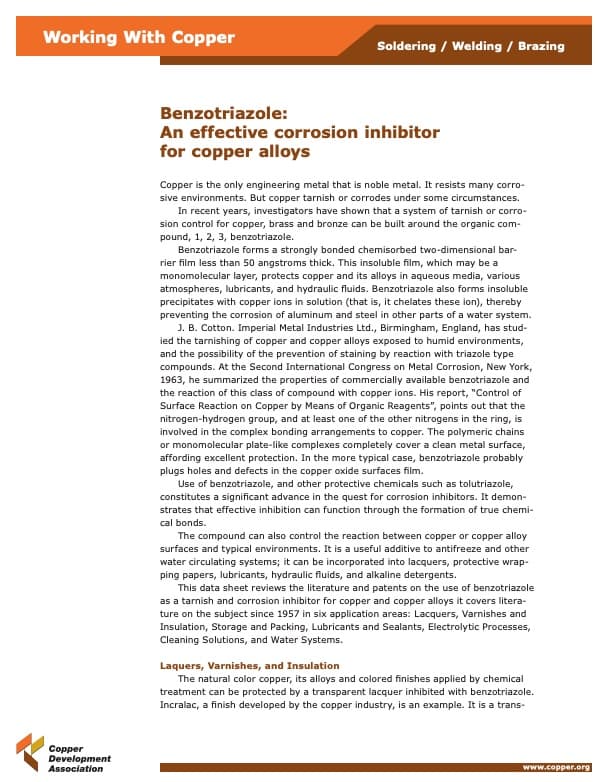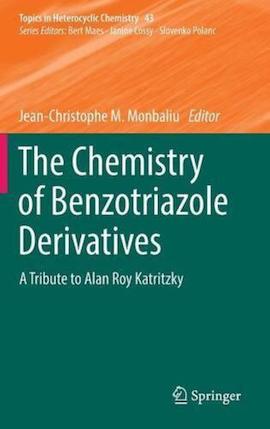
Curated with aloha by
Ted Mooney, P.E. RET

The authoritative public forum
for Metal Finishing 1989-2025

Thread 65/07
Benzotriazole and substitutes for copper corrosion control
Quickstart:
Benzotriazole is an effective anti-tarnish & corrosion inhibitor for copper and copper-based alloys, and puts an ultra-thin coating on the metal. It can be applied by simply dipping the article in a dilute solution of benzotriazole in water, but it is also frequently incorporated in polishes, lacquers, and clearcoats.
Q. Good morning, I've read everything and I'm interested in this story about benzotriazole.
In Italy I have seen that benzotriazole is used in restoration especially when it concerns bronze. Used to block oxidation.
I'm interested in the bright brass.
What I would like to know is if it's possible.
1 - In which solvent should it be dissolved? And in what percentage? Here in Italy we talk about 99.9% ethyl alcohol and benzotriazole from 3 to 6% max.
2- What are the immersion times in the solution for bright brass? In Italy I haven't found any data.
3 - Do the pieces have to be dry?
4 - How do you understand if the product worked well. You can see something visually.
Thank you
SI - Italy
November 10, 2024
publicly reply to Marcello Busini
A. Hi Marcello.
We posted your question on a thread more closely related to it than the one you had replied on ...
1. Benzotriazole is soluble in water, and 0.5% is suggested in this excellent presentation by the Copper Development Association ⇨
However, in my own experience in the plating industry I used proprietary liquid corrosion inhibitors based on benzotriazole, rather than mixing it from powder. You should probably read up on the potential hazards of that if you go that way.
2. The referenced presentation suggests 2 minutes for copper in heated bath; bright brass would probably be the same.
3. The pieces do not have to be dry; in fact, dipping into a dilute water solution is suggested.
4. That's an excellent question that I can't answer -- I hope another reader does!

Ted Mooney, P.E. RET
Striving to live Aloha
finishing.com - Pine Beach, New Jersey
publicly reply to Ted Mooney
![]() Thank you Mr. Mooney for your suggestions. I understand that I will have to try and note the failures and successes. I'll have to get some experience.
Thank you Mr. Mooney for your suggestions. I understand that I will have to try and note the failures and successes. I'll have to get some experience.
- Italy
publicly reply to Marcello Busini
A. Try Incralac, that is proprietary product based on Paraloid B 44 resin and benzotriazole (developed by INCRA). I think that italian firm Bresciani Srl sells it (they sell conservation and restoration equipment and materials).
Hope it helps and good luck!
Be careful - benzotriazole is not something harmless.
Hope it helps and good luck!
- Cerovski vrh Croatia
November 18, 2024
publicly reply to Goran Budija
⇩ Related postings, oldest first ⇩
Q. You suggested using benzotriazole for preventing copper from oxidation and also increasing its shine. Can you give its chemical formula as it is not readily available in the market, else give its substitute.?
vaibhav sondhicables - Delhi, India.
2000
publicly reply to vaibhav sondhi
|
A. Our Laser HFP is a triazole based copper anti-tarnish that is available for export. Dan Brewerchemical process supplier - Gurnee, Illinois publicly reply to Dan Brewer Ed. note: most metal finishing suppliers offer corrosion inhibitors for copper based on benzotriazole or similar -azoles. A. But benzotriazole is readily available; ask your chemical supplier for an anti-tarnish. Citric acid ⇦ this on eBay or Amazon [affil links] is also used for this purpose.  James Totter, CEF - Tallahassee, Florida publicly reply to James Totter, CEF |
Corrosion control for copper with benzotriazole
Q. Can we use benzotriazole as additive in polymer of creating the copper protection film.
Vivek Virkarpacking material supplier - Mumbai, Maharastra, India
2003
publicly reply to Vivek Virkar
A. Hi, Vivek. Sodium benzotriazole is a well known preservative / corrosion inhibitor for copper and it has been added to some lacquer products like Incralac
⇦ this on
eBay or
Amazon [affil links]
and Permalac [adv: Permalac on
eBay]. So the general answer is yes, but whether it is quite compatible with your other materials is an open question so you would need to tell us a bit about your "copper protection film". Good luck.
Regards,

Ted Mooney, P.E.
Striving to live Aloha
finishing.com - Pine Beach, New Jersey
publicly reply to Ted Mooney
[editor appended this entry to this thread which already addresses it in lieu of spawning a duplicative thread]
Bright, reflective, inexpensive and easily applied finish over copper?
Q. I am not a plater. Nor do I have any experience in plating. Yes, I am clueless! And no, I am not going to do the plating.
Here is the situation. We are putting an optical target on a printed circuit board. The target consists of simple stripes about 1/10th inch wide and are the copper conductors. The target is etched just like normal printed circuit traces. However the target needs to remain bright and shiny, but bare copper corrodes in fairly short order.
The coating does not have to be mechanically strong. It is just a surface for light to reflect from. It does need to be smooth. It will be inside a sealed motor, so while it will get up to a maximum of
85 °C, it will never see any nasty weather or ugly environments.
The coating should be inexpensive and easy to apply. A wash of some kind would be easy.
Potential customer - Warrensville, Hts, Ohio, USA
May 29, 2008
publicly reply to Michael Lipphardt
A. Hi, Michael. If I've understood, bright copper would meet your needs. if that is the case, then a dip in dilute benzotriazole ⇦ this on eBay or Amazon [affil links] preservative should work and be easiest. Following it with a lacquer or clear coat sounds easy if necessary..
Regards,

Ted Mooney, P.E.
Striving to live Aloha
finishing.com - Pine Beach, New Jersey
publicly reply to Ted Mooney
Q. Is the clear coat required with the benzotriazole preservative?
Michael Lipphardt [returning]- Warrensville Hts, Ohio, USA
publicly reply to Michael Lipphardt
A. Benzotriazole is a preservative which does not require a subsequent lacquer or clearcoat; it's fully functional by itself. But like anything else, it has its limits. Sorry, I don't know whether just a dip in benzotriazole by itself will meet the corrosion resistance needs of your application or not. Keeping something shiny indefinitely is inherently difficult.
Regards,

Ted Mooney, P.E.
Striving to live Aloha
finishing.com - Pine Beach, New Jersey
publicly reply to Ted Mooney
Copper Finish for thermal heat spreader
Q. My company currently finishes our copper heat spreaders with a nickel plating to prevent corrosion.
My colleague and I have been searching the net to determine if there would be a better finish for the copper.
We require a finish that would not inhibit the thermal transport properties of the copper heat spreader. Some have suggested a benzotriazole finish. Is this a better finish than the nickel plating? Does it add any significant thickness to the part?
Thanks in advance.
- Rancho Cucamonga, California, USA
July 7, 2014
publicly reply to Cory Steen
A. Hi Cory. Benzotriazole is a far more temporary tarnish inhibitor than nickel plating. The thickness is millionths of an inch, perhaps one molecule. If the environment is benign it probably has a chance of working for a while, but its long term corrosion resistance in anything worse than a climate controlled room would probably be minimal. Good luck.
Regards,

Ted Mooney, P.E.
Striving to live Aloha
finishing.com - Pine Beach, New Jersey
publicly reply to Ted Mooney
Q. Sir,
Can anybody suggest a cheap substitute for copper inhibitor benzotriazole?
- ajmer, rajastha India
December 15, 2018
publicly reply to akash sharma
A. Hi Akash. We added your question to a thread where James Totter proposed citric acid as a possible substitute. It may be a satisfactory substitute in some ways for some applications, and wholly unsatisfactory for others. Please get back to us with details or after you test it. Good luck.
Regards,

Ted Mooney, P.E. RET
Striving to live Aloha
finishing.com - Pine Beach, New Jersey
publicly reply to Ted Mooney
A. Tolyltriazole is about as effective. Sometimes it is a little more expensive, sometimes a little less expensive. There is no cheap effective substitute. But if you want something cheap and can accept a significant reduction in performance you could try triethanolamine or a similar compound.

Tom Rochester
CTO - Jackson, Michigan, USA
Plating Systems & Technologies, Inc.

publicly reply to Tom Rochester
Closely related topics:
• Thread 20135, "Preserving bright copper using benzotriazole solution"
• Thread 4170, "Tarnishing of brass and copper plating"
Or Search the Site with your own search term.
Q, A, or Comment on THIS thread -or- Start a NEW Thread


